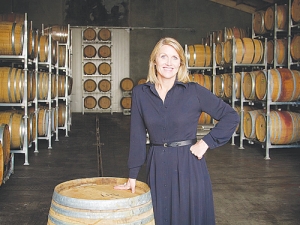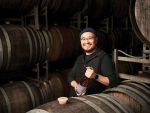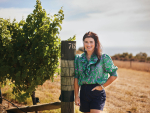On 1 September this year, she was handed the hefty reins of her new role as chief executive officer of Palliser Estate; one of the largest producers in a region of tiny wine companies. The entire Martinborough wine industry produces 1% of New Zealand's wine each year; the Wairarapa in its entirety makes 2%. Being a big producer here is a soberingly relative concept.
Goodwin began her working life as an accountant and management consultant in 2003. She worked her way through New Zealand, London, Australia before leaving business for wine. And now, in a planned twist of fate, Goodwin has landed the job that she says she always dreamt about: combining her wine passion with her business experience.
The passion part was ignited when she first left university and found herself flatting with a member of the Wellington wine trade; "We used to do a lot of wine tastings in Wellington because of that flatmate, and I loved it."
Then, living in London in the mid 1990s, Goodwin visited Burgundy. That was the beginning of the end; "It was no-turning-back after that. The place, the product and the romanticism of the industry there all lured me into thinking seriously that I wanted to get into the wine industry one day."
It was really only a matter of time as to where, how and when.
In 1997, back from overseas, Goodwin started work as a management consultant; an interesting way to look at businesses in Sydney, Auckland and Wellington, she says.
"That experience has helped to prepare me for the latest challenge here at Palliser; I am aware it is a big role I am stepping into, but over the past decade at this winery, I have been involved closely in all aspects of the business, so I have some understanding of what is taking place here and what we need to do to move forward in such a crowded wine market."
Like many seemingly overnight success stories, however, Goodwin's has been several years in the making.
In the early 2000s, one of her close friends embarked on the Eastern Institute of Technology wine course in Hawke's Bay and she suggested that Goodwin might like it.
"I decided to give it a go, and found it so interesting that I decided to pursue winemaking as a career."
Her first vintage was in 2003 at Gisvin followed by vintages at Nga Waka and Saintsbury in Carneros, California.
"I had three very different experiences and loved it so in 2004, I went to Lincoln University and did the post graduate Diploma in Viticulture and Oenology."
She was then offered a year long role at Palliser Estate by winemaker Allan Johnson, who has since been a great mentor to Goodwin.
"I was incredibly lucky to get such a great position straight off and for the past 10 years at Palliser, I have been involved in all aspects of the business from environmental management, financial involvement and winemaking to looking at the business as a whole," she says.
"While we are a large winery for Martinborough, we are relatively small in the big scheme."
The Palliser business model is for the company to retain all of its own vineyards and split the fruit across two labels; the flagship wines are Palliser Estate, and the more accessibly priced, higher volume wines are Pencarrow. This makes for a not-quite-even split of approximately 40/60 among the two ranges. Last year the winery launched a rose for the first time and Chenin Blanc also interests Goodwin, who sees it as adding another strong string to the company's predominantly white wine bow. At present, approximately 40% of the production is devoted to Sauvignon Blanc.
Challenges ahead
Sauvignon Blanc is the biggest challenge for Palliser Estate and for New Zealand, says Goodwin.
"It has such dominance on our export market and there is this talk about a movement away from New Zealand Sauvignon Blanc. That is a risk to the industry. We have to keep ahead by innovating, keeping quality high and also looking at other possible emerging trends."
Goodwin says it is important for New Zealand winemakers to remain not only true to their own brand, but also to stay keep ahead of the game.
"Allan (Johnston) is always looking at different ways of doing things and I think we have to be leaders as New Zealand wine producers. With Sauvignon Blanc, we used to be very controlled; now we are introducing wild yeast. With our Chardonnay, for example, we have to let our fruit be the hero. I think it's believing in what we do."
For Sauvignon Blanc, as for Chardonnay and Pinot Noir, Goodwin has one overriding mantra: "Less is more."
This philosophy led to winemaking modifications at Palliser Estate, which now embraces wild yeast fermentations, actively uses less malolactic fermentation and has dialed down the inclusion of new oak.
Solids ferments have yet to make their presence felt in the winery's Chardonnays, but the aim has been to make full bodied whites with a hint of flint. Another innovation will be the use of Chardonnay clone 548; now planted at Palliser, it is in New Zealand via Riversun Nursery.
"Chardonnay does very well in our cool climate here. The wines can age beautifully as well as drinking well on release; while it's something we're not especially known for, I think the Chardonnays are getting better each year."
Change is not top of mind for Goodwin, whose aim is to steer the Palliser ship in a more high profile direction going forward, but otherwise plans to keep things largely as business as usual. That said, rebranding will feature on the company's label for the 2015 Chardonnay and her main crusade is to lift the profile of Palliser wines.
"It is world class wine and I think we are often forgotten when it comes to New Zealand's strong wine brands. I have the impression that in some circles, Palliser is seen as commercial, but we're actually small," Goodwin says.
"A large part of Palliser's success has been due to Richard's (Riddiford) very strong leadership and unique style of marketing. I am very aware that I have big shoes to fill and I'm very aware that those big shoes are not very far away because he remains living in Martinborough and plans to retain his breakfast appointment at Café Medici every morning."












